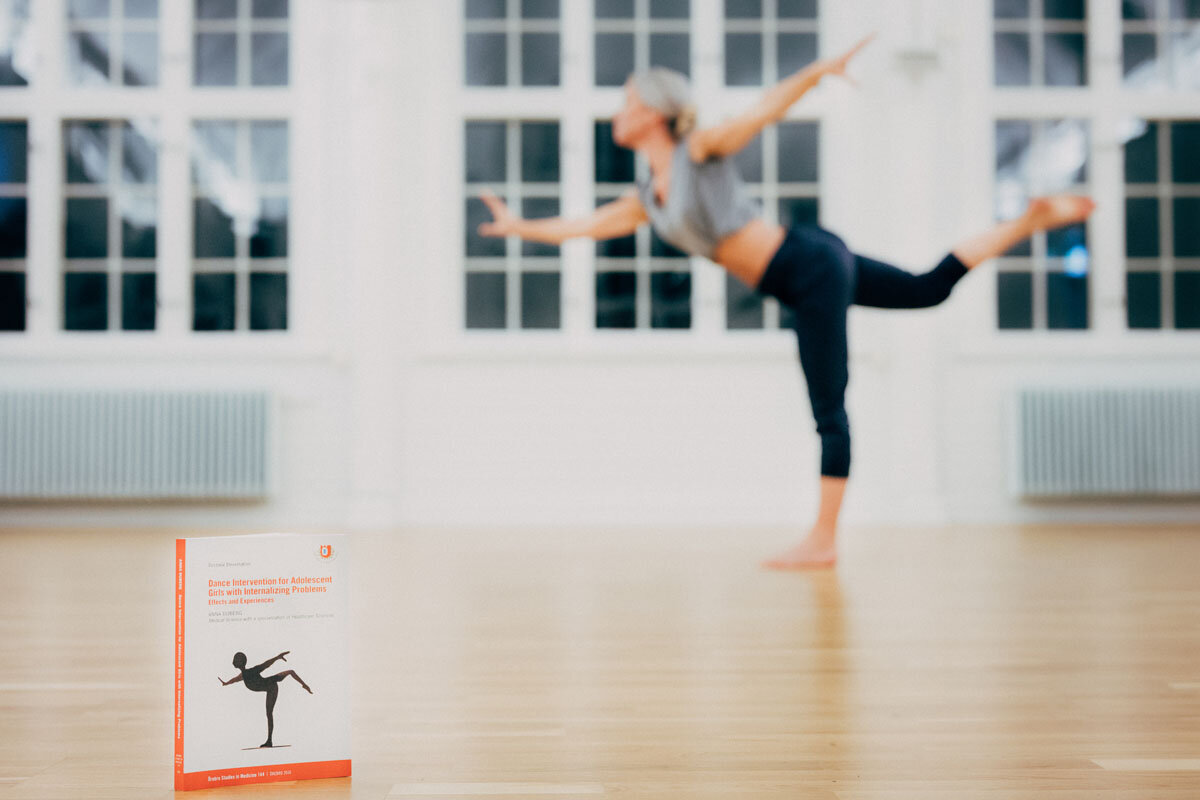Research
Physical and emotional symptoms such as headaches, stomach pains, stress, anxiety and depression in young people are a common problem. In addition to individual suffering, this represents a major societal cost and an increased risk of social exclusion, depression and anxiety problems. Non-pharmacological and easily accessible treatment options are needed to address this problem.
"Dansprojektet" is a randomized controlled trial from University Health Care Research Center, Region Örebro Län, with the aim of investigating the effect of supplementing student health with undemanding dance for girls 13-18 years old with symptoms of mental illness. Professor Margareta Möller came up with the idea for the study and was the main supervisor. Region Örebro County was the main financier. Leg. physiotherapist Anna Duberg designed the intervention and was a doctoral student (Örebro University, Department of Health Sciences). A total of 112 girls with recurrent somatic and/or emotional problems were included in the study's analyses. Dance was given twice a week for 8 months and the focus was on the joy of movement and not performance. See publications below, see the reference list or read the Swedish summary report. The study was conducted in 2008-2011.
Results showed that the dance group compared to the control group increased their self-rated health and reduced somatic and emotional symptoms after the intervention. Health economic analysis shows cost effectiveness - due to increased quality of life, reduced number of school nurse visits (54% in the dance group and 25% in the control group reduced the number of visits), and that dance is a relatively inexpensive intervention.
The undemanding atmosphere and supportive community were of great value to participants, as revealed in the qualitative analyses. Dance was seen as an oasis from stress, a refuge from high individual and socio-cultural perceived demands. The central understanding of the girls' experiences was 'Experience embodied self-confidence that opens new doors'. This increased self-confidence generated joy and energy and a new ability to 'take up space' both spatially and metaphorically.
The Dance for Health method is currently being implemented throughout the Nordic region, which is based not only on the results of the Dance project but also on the evidence for physical activity in mental illness, as well as on the broad experience of using the method across the country. Local follow-ups show good results and several municipalities have chosen to offer the method as part of the student health service for several years. More research is needed to strengthen the evidence*.
How can it work? In addition to the obvious physiological effects of regular heart rate increasing physical activity, one of several possible underlying mechanisms is the presence that undemanding dance provides. Presence provides the opportunity to experience the joy of movement and offers a shift of focus "from thoughts to body" that can feel mentally restful. Since aging is often part of mental illness, i.e. being stuck in negative thought patterns and anxiety, dance's focus on moving one's own body to music can be particularly valuable. Conscious presence, but also strengthened body awareness increases well-being. The sense of social inclusion and belonging to a safe group is also a central part of explanatory mechanisms.
The WHO emphasizes the importance of strategies to improve the mental health of young people. Dance is an example of a health economically effective and physically active intervention that strengthens positive lifestyle habits for the target group. As a non-pharmacological preventive and complementary treatment intervention in groups, dance has the potential to reach many people and thus make a big difference with small resources.
Dance for Health is based on the Dance Project's method and was developed with the support of the Social Impact Lab at Örebro University, headed by Åsa Allard. Today, the organization is run as both a company and a non-profit association.
*Clarification regarding dance research in general, there is no doubt that more review studies are needed in the area, although the number of studies is increasing, dance is a narrow area. Today, a new systematic review has been published (Noetel M, et al. Effect of exercise for depression: systematic review and network meta-analysis of randomised controlled trials. BMJ. 2024 Feb 14;384:e075847. doi: 10.1136/bmj-2023-075847. PMID: 38355154; PMCID: PMC10870815.) which highlights that dance may have promising effects on depression. Also Tao et al (Tao D, et al, 2022, The Physiological and Psychological Benefits of Dance and its Effects on Children and Adolescents: A Systematic Review. Front. Physiol. 13:925958. doi: 10.3389/fphys.2022.925958) conclude that dance provides health benefits for young people and implementation should be seriously considered. Regarding the overall global research base, physical activity in mental health is the starting point, as it far exceeds the smaller area of dance.
PUBLICATIONS - Dance Project - Dance for Health
Duberg A. Dance intervention to strengthen mental health in teenage girls. Socialmedicinsk tidskrift 2020;05-06(97):878-887. https://www.socialmedicinsktidskrift.se/index.php/smt/article/view/2299
Sandberg E, Moller M, Sarnblad S, Appelros P, Duberg A. Dance intervention for adolescent girls: Effects on daytime tiredness, alertness and school satisfaction. A randomized controlled trial. Journal of Bodywork and movement therapies 2020; sept 16, proof DOI:https://doi.org/10.1016/j.jbmt.2020.09.001
Duberg A, Jutengren G, Hagberg L, Moller M. The effects of a dance intervention on somatic symptoms and emotional distress in adolescent girls: A randomized controlled trial. Journal of International Medical Research 2020;48(2) 1-12. DOI: 10.1177/0300060520902610
Carlsson N, Kullberg A, Johansson I, Bergman P, Skagerström J, Andersson A. "Exploring experiences among adopters during the diffusion of a novel dance intervention in Sweden". International Journal of Qualitative Studies on Health and Well-being, 2018;13:1, 1438697
Duberg A, Moller M, Sunvisson H. "I feel free": Experiences of a dance intervention for adolescent girls with internalizing problems, International Journal of Qualitative Studies on Health and Well-being 2016;11:31946.
Philipsson A, Duberg A, Moller M, Hagberg L. Cost utility analysis of a dance intervention for adolescent girls with internalizing problems, Cost Eff Resour Alloc 2013;11(1):4.
Duberg A, Taube J, Möller M. Dance can give young people protection against mental illness. Läkartidningen 36/2013
Duberg A, Hagberg L, Sunvisson H, Moller M. Influencing self rated health among adolescent girls with dance intervention: a randomized controlled trial. JAMA Pediatr 2013;167(1):2731.


